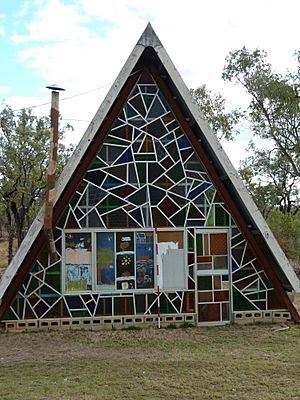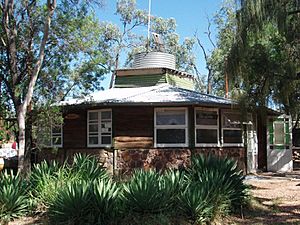Tomahawk Creek Huts facts for kids
Quick facts for kids Tomahawk Creek Huts |
|
|---|---|

"Buckingham Palace" hut, 2011
|
|
| Location | Argyll, Central Highlands Region, Queensland, Australia |
| Official name: Tomahawk Creek Huts | |
| Type | state heritage (landscape, built) |
| Designated | 16 October 2008 |
| Reference no. | 602661 |
| Significant period | 1960s, 1980s (fabric) 1960s-1990s (historical use) |
| Lua error in Module:Location_map at line 420: attempt to index field 'wikibase' (a nil value). | |
Tomahawk Creek Huts are a special group of old buildings located in a remote part of Queensland, Australia. These unique huts are near the towns of Argyll and Rubyvale. They are listed on the Queensland Heritage Register, which means they are important to the history of the state. This listing happened on October 16, 2008.
Contents
History of the Tomahawk Creek Huts
The Tomahawk Creek Fossicking Area is about 25 kilometers west of Rubyvale. It is a very remote part of the Central Queensland Gemfields. This area is about 2,340 hectares in size. The first huts were built here in the 1960s. People built them on their mining claims or with a Miner's Right.
What is Fossicking?
In 1986, a new law made the area a "fossicking area." This meant the huts became illegal, and the people living in them were called "squatters." Fossicking areas are places where the government allows people to search for gems or minerals. Commercial mining is usually not allowed in these areas.
In Queensland, there are 11 special fossicking areas. Five of these are in Central Queensland. Here, you can camp with a permit for up to three months. In other parts of Queensland, camping is not allowed in fossicking areas.
Early Gem Mining in Queensland
The first sapphires were found in the Central Queensland Gemfields in 1870. This discovery brought many hand miners to the area. In the 1890s, people from Russia and Germany became interested in sapphires. This made the market for gems grow.
However, this good time ended with World War I and the Russian Revolution. The government helped miners stay on the field. The market slowly recovered in the 1940s. For many years, gem miners lived in tents or built simple huts. These huts were made from tin, poles, and recycled materials. Small towns like Anakie, Sapphire, Rubyvale, and The Willows grew up around the gemfields.
How the Huts Developed
In the 1960s, the price of gems went up. More tourists and gem collectors came to the fields. In 1965, machine mining started with the first use of a bulldozer. Thai buyers began visiting in 1971, and more gems were found. Heavy machinery mining became very common.
By the late 1970s, activity slowed down. But a group of machinery miners and hand miners stayed. The Gemfields also became a popular holiday spot for campers. Many people visited during the cooler months.
Fossicking at Tomahawk Creek was popular in the late 1960s. This is when the oldest huts that are still standing were built. Most people stayed during winter or holidays. In 2007, there were 13 huts used for holidays and six huts where people lived permanently.
Many huts started as caravans. People added extra rooms and lean-tos to them. They used walls and roofs made of metal sheets. They also used "billy boulders" (large, hard stones) and other light materials. Toilets and showers were usually built a few meters away from the main hut.
Tomahawk Creek is a fossicking area, so large machines have not been used for mining. Instead, hand miners and tourists explore and dig here. The last official mining claim ended around 1991. After that, only two people applied for permits to live there. Most other huts do not have legal permission to be there.
Famous Huts of Tomahawk Creek
The hut called "Tomahawk Heights" is on lot 9. It is mostly made of metal sheets. It was built after 1969 on an old camp spot. Four people use it sometimes.
The biggest hut is called "The Lodge." Hans and Eva Hendrickson built it before 1984 on lot 17. They even had a small shop inside. Now, it is used as a holiday home.
An A-frame hut known as "Camp David" was built in Mackay. It was moved to Tomahawk Creek and rebuilt in 1981. This hut is on Crystal Hill on lot 8. Its front wall is made of colorful glass.
Another hut on lot 4 is made of "billy boulders" and bottles. It has three caravans attached to it. The person who used to live there full-time moved to a town in 2008.
The people who live in these huts often act like a community. They meet regularly and help each other. They share things like shopping trips and rides to the doctor. They feel a strong connection to the place and its huts. They also look after each other's huts when owners are away.
What the Tomahawk Creek Huts Look Like
Tomahawk Creek is a hilly area of bushland, about 2,340 hectares in size. You can reach it by driving 17 kilometers on an unsealed road. This road is called the Reklaw Park track. It leaves the Clermont Road 27 kilometers from Rubyvale. Tomahawk Creek forms the north-western edge of the area. Mount Hoy is a tall, rocky peak in the south-west.
When you reach the entrance, many tracks run through the area. The main track runs along Hut Creek, where most of the huts are located.
In 2006, there were 21 huts in the area. Five of them are now empty. The huts range from five to 50 years old. Most were built around old caravans. They have canvas awnings and roofs and walls made of metal sheets. These are held up by poles made from bush timber, tied with wire. Many huts use recycled materials.
Some huts are partly built with "billy boulders." These stones are often used for the lower walls and outdoor barbecue areas. The huts have open areas to let air flow through. This helps keep them cool in the summer heat. Three of the huts are very close to each other, about 250 meters apart.
The Lodge Hut
A stone hut called "The Lodge" is on lot 17. It is the strongest building in the area. It has 12 sides, like a dodecahedron shape. The walls are made of "billy boulders." Above these, there are horizontal logs with different kinds of recycled windows.
Around the bottom of the hut, there are air vents made from barrels. These can be opened to let air in. More air flows through the roof, which has metal slats that can be opened from inside. A water tank sits on top of the roof, held up by a central pole. The roof is made of metal sheets.
The hut has a generator for electricity and a solar panel. The solar panel charges 24-volt and 12-volt batteries. Inside, there is a wooden stove. Its fireplace is made from a large metal wheel. There is also a regular wood-burning stove. Like other huts, the inside walls are made of light materials. These include hessian, scrap wood, and metal.
Camp David Hut
An A-frame building called "Camp David" is on Crystal Hill, on lot 8. It was built somewhere else and then moved here in 1984. It is about 9 meters long, 6 meters wide, and 6 meters tall at its highest point. The roof is made of Trimdeck metal sheets, held up by steel supports.
Inside, it has a mezzanine level for sleeping. This is like a half-floor. There is also a staircase. The floor is made of brick pavers. A generator provides power to the hut. The front wall, which faces east, is made of colorful pieces of glass. These are held in place by aluminum strips.
Other Unique Huts
A hut mostly made of "billy boulders" and bottles is on lot 4. Three caravans are on this site. They are used as extra rooms attached to the main hut.
A hut known as "Tomahawk Heights" is on lot 9. People started building it after 1969. The person who lived there had camped in that spot before. The walls are mostly "billy boulders." It also has parts of an older building. A solar panel and batteries provide power. It has a stone fireplace and an outdoor barbecue.
Why Tomahawk Creek Huts are Special
Tomahawk Creek Huts were added to the Queensland Heritage Register on October 16, 2008. They met certain rules to be listed as important heritage sites.
A Glimpse into Queensland's Past
These huts show us how Queensland's history has changed. They are especially important for understanding the Central Region Gemfields. They show a unique way of life for people who searched for gems. These people used simple tools and built their homes from recycled materials. The huts date back to the 1960s, with more parts added in the 1980s.
A Rare Way of Life
Tomahawk Creek shows a way of life that is now becoming rare. Living on the land like this used to be common. But now, land use is more controlled by rules. The clever ways people built these huts to live in a hot, dry climate are also rare.
Camping in fossicking areas is now limited. In Central Queensland and some remote western areas, you can only camp for up to three months. The government also removed the "Miner's Right" for fossicking areas. This has led to fewer huts like those at Tomahawk Creek. These huts are now rare and might be the last of their kind.



